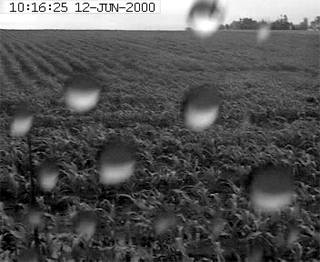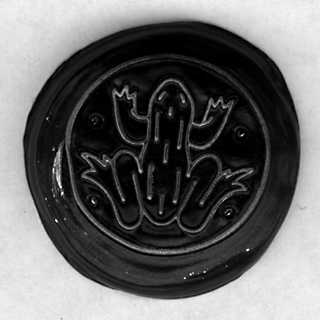| | - 11 June 2000
- Umlaut Ranch
- In 1894, Ernst Young founded the Umlaut Ranch not too far from Seven Pines, Utah. Young, a European immigrant, was as lazy as he was prudent. Or perhaps he was merely practical: his descendants claim the old man figured that a couple of dots would be about one of the easiest brands to create.
The Umlaut Ranch was doing pretty well until the first world war came along. With Americans suffering from an epidemic of Teutophobia, people began to disparage the Umlaut Ranch. Young’s neighbors muttered darkly about “beef going to the Hun.” Young responded by renaming his ranch, “The Lazy Colon.” After all, an umlaut is merely a horizontal colon, no? Young’s semantic ploy worked, and by the second world war almost no one in Three Pines remembered Young’s Germanic roots. By the 1960s, though, few Americans were still worried about the Germans. On the other hand, who could resist making jokes about diarrhetic cows? (Lazy Colon: get it?) And so it was that in 1971, the descendants of Ernst Young—who by this time was quite dead—decided to revert to the original name. Despite evidence to the contrary, it seems that some things never change. The Umlaut Ranch is once again called the Umlaut Ranch. And, in the words of a Seven Pines octogenarian, its brand still looks like “two spooky eyes staring out of the butt end of a cow.” 

- 12 June 2000
- CornCam Discipline
- I received a fascinating invitation from Iowa Farmer Today. (Although this seems like a redundant comment, I received the solicitation today.)
Watch corn grow!Count the ears in this Iowa cornfield! See it tassel! Cheer as the mighty cornstalks battle wind, hail and rainstorms! Bring your friends back to see the plants as they reach for the sky!
- But since Iowa is thousands of kilometers away (albeit not far enough), how can I see these events?
The answer is as predictable as it is lame: the Internet in general, and “CornCam” in particular. Every fifteen minutes, the CornCam publishes a new image of Jim and Sharon Greif’s cornfield near Prairieburg. Iowa Farmer Today boasts that more than a hundred thousand people have watched corn grow in the last couple of weeks. I quite like CornCam. For example, the image created at 10:16:25 (Iowa time) this morning shows large drops of water on the CornCam lens. I can’t remember the last time I ever saw such an image by a “serious” photographer. CornCam may be the perfect illustration of Garry Winogrand’s approach to the photographic medium. “I try to be as dumb as the camera. It’s an immense discipline.” 
- 13 June 2000
- Ted Orland’s Scenes of Wonder & Curiosity
- I ran across a copy of Ted Orland’s 1988 book, Scenes of Wonder & Curiosity, on a friend’s bookshelf. My discovery surprised me; I thought I was vaguely familiar with most of Ted’s work. Obviously not.
Here’s how Ted reviewed his book: “Much as I like to view myself as a photographer, I suspect the writings may be the more important part of this book—written in the immediacy of the moment, they encompass a turbulent decade in my own life, and a time when photography itself finally began to be recognized as a fine art by the outside world.”
- I was impressed by the images; I’d forgotten how good photography can be. I found the words very moving, but perhaps not in the way Ted intended. Ted captured the feeling of an era, the time when I first picked up a camera in the early 1970s.
Back then, the art of photography was fairly well-defined. Photographers lived in their own ghetto with clearly-marked borders. Almost everyone agreed that Ansel Adams (with whom Ted worked), Eugene Atget, Henri Cartier-Bresson Walker Evans, Robert Frank, and Edward Weston all made fine photographs. When I, as a young photographer, made work that manifested some of the qualities associated with recognized photographers, I was told that I was on the right path. As a novice, I found it immensely reassuring to know both that there was a path, perhaps even the path, and that I was on it. I feel a little bit nostalgic when I look back at those days. A little, but not much. The change, “when photography itself finally began
to be recognized as a fine art by the outside world,” didn’t occur until photographers left their ghetto for the larger and more diverse art ghetto. The pillars of traditional photography are still standing, but you can’t see them from where I am. Ted did a wonderful job of capturing the feeling of a period, and reminded me that are still many new scenes of wonder and curiosity to be experienced. 
- 14 June 2000
- That’s Art!
- I’m at Morrie and Lynn’s place, or at least that’s how I still think of it. Of course, it’s been just Lynn’s place since Morrie died last August. I’m still young enough to be unfamiliar with the loss of a friend, and it’s eerie to wander around here, continually thinking of him, and realize I’ll never see him again. Eerie and sad.
I find it particularly unsettling to poke around his studio and see most of his life’s work, neatly organized by date and project, in tidy stacks of acid-free boxes and rows of print cabinets. There it is, almost everything he ever did over several decades, just sitting there in the cool darkness. He worked hard all his life, then he died, and now most of his work remains unseen. That’s art! 

- 15 June 2000
- Excellent Wine Advice
- Robert brought a bottle of Frog’s Leap 1997 Cabernet Sauvignon to dinner tonight. I found it very entertaining, and not for just the usual reasons. I read the label on the back, and the usual marketing drivel concluded with a surprising admonition: OPEN OTHER END.
So I did. 
- 16 June 2000
- Tired and Unappreciative Workers
- I went out for drinks tonight with some people who have regular nine-to-five jobs. It was rather depressing to see how miserable they were at the end of another long week. One person after another described their harrowing work schedules, and said how rejuvenated they felt after taking a whole week off from their job. They all agreed that taking a break or two a year was a damn good idea.
I wanted to join in the conversation, even though it’s been a couple of decades since I had a real job. I came up with a story from my recent past that I thought would support their theory. I told them that, after not having worked for six months, I decided to help my friend Eileen at her company for a day. I related how I arrived at nine in the morning, worked all day, then panicked just before five. I was supposed to mail a letter, but I couldn’t find a stamp. I was under a tremendous amount of stress, but eventually found a stamp. Whew! I concluded the story by saying that I, too, understood how stressful work must be, especially for people who work several days a month or more. The grumpy workers didn’t seem to appreciate my support; I guess they were too tired. The evening ended up on a positive note, though: someone used a company credit card to pay for the entire bar tab. 
- 17 June 2000
- Coulrophobia
- I recently added a new word to my modest vocabulary, coulrophobia. The traditional thing to do after making a discovery is to announce it to the world, and that’s exactly what I did. I told all my friends that there’s a word for fear of clowns: coulrophobia.
I was surprised by the response. It turns out that almost everyone I know hates clowns, and more than a few had been traumatized by the buffoons when they were children. Once again, I am astounded by what goes on in the minds of other people. My challenge, as always, is to reciprocate. 
- 18 June 2000
- A Useless Query
- Hot water heaters don’t heat hot water; they heat cold water. Someone needs to do something about this widespread misunderstanding. I’d lead the crusade, but I have better things to do.
That’s my story, and I’m sticking to it. 
last transition | index | next transition
©2000 David Glenn Rinehart
| |

